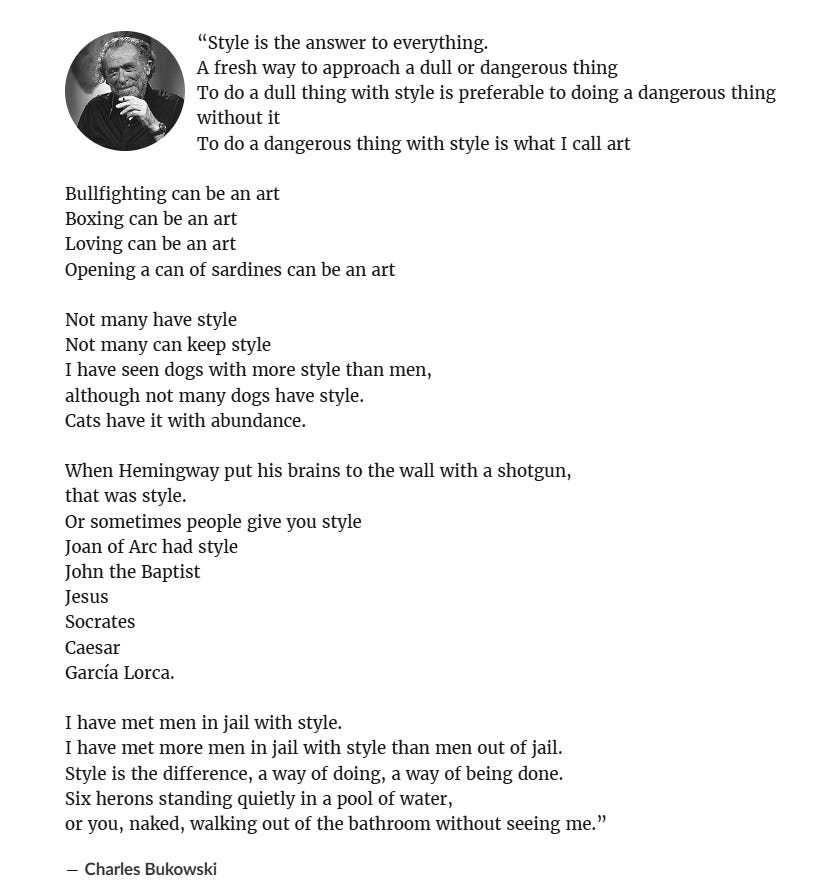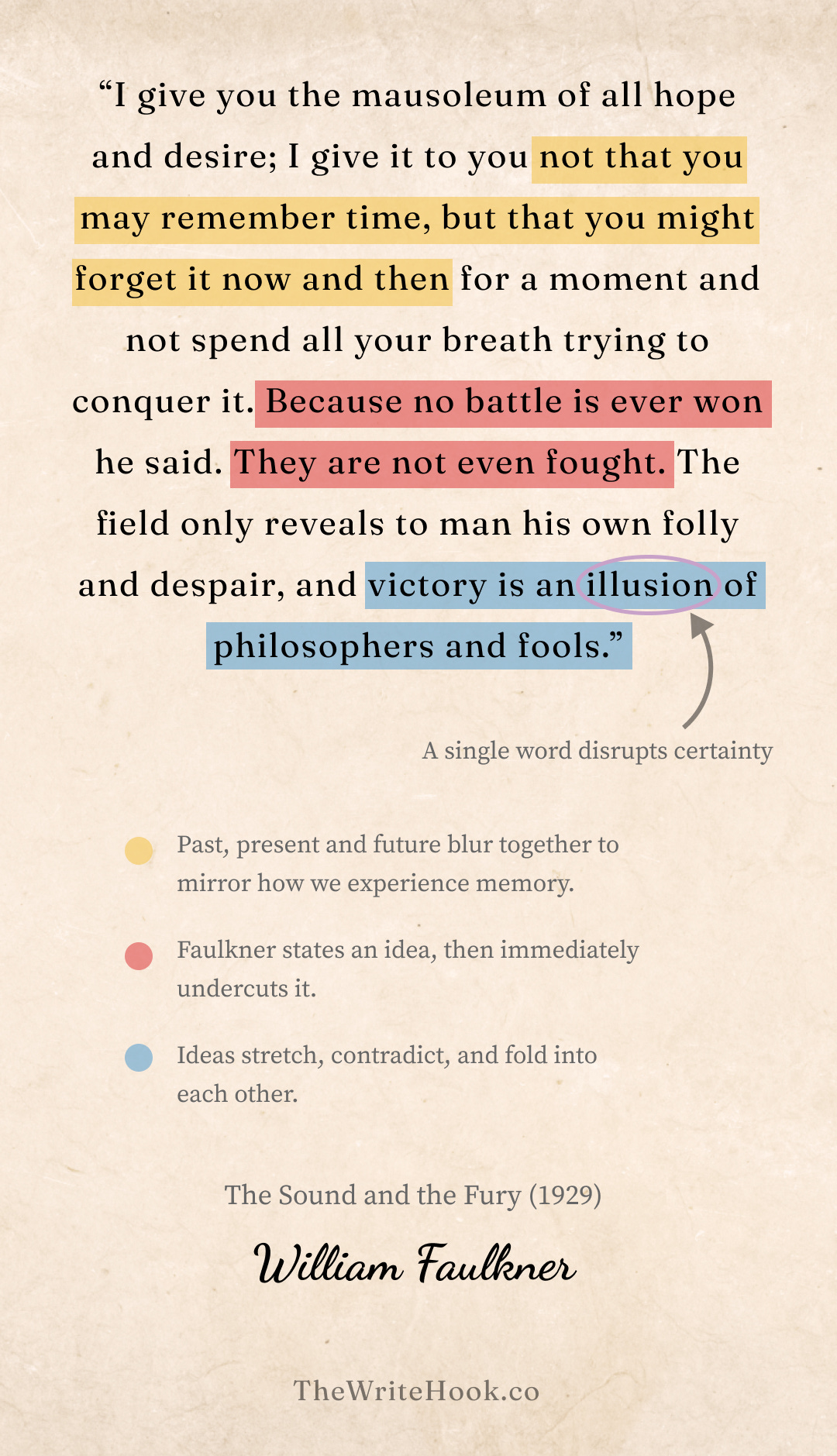Style is the answer to everything
Why some writing lasts for centuries when most is forgotten and how your style decides where yours will end up.
👋 Hey, it's Akanksha. Welcome to The Write Hook! If you are new here, here’s what you missed last month.
Subscribe to get access to these posts, and all future posts.
Read time: 6 minutes
The first rejection letter called Emily Dickinson's poetry "spasmodic” (erratic). The second called it “uncontrolled.” The third suggested she learn proper punctuation. The editors and critics of her time didn’t know what to make of her style that has dashes, abrupt capitalization of words and compressed rhythms.
Here’s an example of what they found so difficult to understand:
(I suggest you read it out loud. Poetry often sounds better that way)
I’m Nobody! Who are you?
Are you – Nobody – too?
Then there’s a pair of us!
Don’t tell! they’d advertise – you know!How dreary – to be – Somebody!
How public – like a Frog –
To tell one’s name – the livelong June –
To an admiring Bog!
The dashes here create pauses and moments of silences. When Emily writes "How dreary – to be – Somebody!", those breaks force you to slow down, to feel the weight of each word. Her capitals turn abstract ideas into living things – "Nobody" and "Somebody” — becomes something important. And, the final image of a frog croaking to an “an admiring Bog”, turns social ambition into something small and absurd.
Emily wrote nearly 1,800 poems this way, out of which only 10 were published when she was alive. After her death, when her poems were being published, editors “corrected” her punctuation, standardized her capitals, and smoothened out her rhythms. They tried to make her sound normal.
It took seventy years — seventy years — before someone finally had the courage to publish her poems exactly as she wrote them.
With Emily’s poems, the editors saw a bunch of incorrect dashes and capitals. But Emily saw a new way to make people feel something.
There was a reason why those editors were compelled to publish her poetry. They could see the substance in it but thought, they need to remove her eccentric style from it. They failed to see, her style is what was adding a new layer of meaning to it.
How you say something is inseparable from what you're saying.
This is true across all creative disciplines. Picasso captured it best when he said:
Some painters transform the sun into a yellow spot, but there are others who with the help of their art and their intelligence, transform a yellow spot into the sun.
Anyone can paint a yellow circle. But to make the viewer squint, to make them feel the heat on their skin, to force them to look away, to turn a yellow spot into the sun — that's style.
Some say style is innate – you either have it or you don't. Others think of it as a technique you can master. But here’s the thing: You can learn the technique. You can have the talent. You can also be a genius. And still, you may not have style.
Charles Bukowski understood this better than most:
Most people see style as something you add — a flourish, a signature, a way to stand out. But style actually works in the opposite direction. It is what remains after you've stripped away everything that isn't essential. Everything that isn't you.
It shows up in moments of danger and in moments of love, in acts of rebellion and in acts of surrender. When instincts take over and pretense falls away.
That's why style can't be copied. You can imitate the surface level things — the brush strokes, the word choice, the way someone moves. But true style comes from somewhere deep within. From all the things you've lived through and thought about and tried to understand. From your particular way of seeing the world and what you think matters in it.
Writing in Style
In 1929, Ernest Hemingway and William Faulkner both wrote a book. And they both became famous for their different styles.
Hemingway is known for his minimalist style. His sentences are short, actions are precise, and emotions are distilled to their rawest essence. His style leaves space for the reader to engage and to feel the weight of what is left unsaid.
Here’s an excerpt from A Farewell to Arms:1
This is Hemingway at his sharpest — bare, precise, leaving the weight of the words to settle on the reader.
Hemingway believed in delivering clear & definite truths but William Faulkner dismantles the very idea of absolute truth in his writings.
When you read the works of Faulkner, his sentences are long, layered and filled with subtext. He captures the consciousness of his characters in streams of their thought, inviting the reader into their fractured and messy worlds.
Consider these lines from The Sound and the Fury:
Faulkner doesn’t show us a man reflecting. He shows us a man trapped inside his own reflections. When his characters experience events: they relive, reframe and reinterpret them endlessly, like ghosts haunted by time itself.
You can’t just passively observe when reading Faulkner, you have to wrestle with the flow of ideas to find meaning.
The style of the author changes how readers live in the worlds created by them. Hemingway offers clarity and space to the reader while Faulkner offers depth and complexity. Both lead to certain truths, but the experience it offers is entirely different.
It shows how there’s no good vs bad in style. But rather how someone’s unique approach to life and their craft can have a unique effect.
Now the question is, how do you develop your own style? Or how do you find it? Or better yet, how do you create situations that lets your style emerge?
Style must be cultivated yet cannot be forced.
Developing a genuine personal style requires intentional exploration and choice. It's like personality – you can't directly choose who you are, but you can create conditions that allow your style to emerge.
There’s a concept of “mushin” (no mind) in Zen philosophy and Japanese martial arts — a state where your style is most authentic because you are not thinking about it. You have an unconscious fluency in your craft. A natural flow that can only be reached through intense conscious practice.
It's a developmental journey from unconscious incompetence (no style), to conscious incompetence (awareness of style but unable to achieve it), to conscious competence (deliberately executing style), and finally to unconscious competence (style flowing naturally).
At this point, style is no longer something you try to create — it emerges as a natural extension of who you are and what you care about.
Style is survival
Time is the best filter for excellence. It filters out everything that is mediocre, merely competent and most things that blend into the noise. Only what is distinct survives.
Style is not about standing out for the sake of it. It is about creating something undeniable— something that carries weight, something that just screams YOU.
Hemingway and Faulkner did not set out to be different; they set out to be honest. Their styles emerged from necessity, from the demands of what they wanted to express.
Emily even got punished for style in a way. But she kept at it because there was just no other way for her to express what she wanted to express.
Style, at its core, is a survival mechanism. It makes someone pick a book centuries later and still feel its importance because of the idea and how it is expressed.
You won’t find style by chasing it. You build it by showing up. Making choices. Refusing to compromise on what matters. Refining what you believe in. And when you do it long enough, a distinct style will be part of your creations, your way of being and a living extension of you.
Take care and have a creative week.
Much love,
Akanksha 🌻
Hemingway and Faulkner’s writing style analysis is inspired by Writing Examples






Insightful article, Akanksha. Thanks for sharing. I'm glad you mentioned Hemmingway and Faulkner instead of Hemmingway vs Faulkner -- it's not a fight but a choice.
Based on what you've covered in this article, would it be fair to say that style is mostly subconscious? As in, we can't put a finger one what it is or how it came to be; unlike craft, which, I think, is a conscious process.
I feel building style can be a deliberate process and developed over time, consciously. For instance, how Fitzgerald and Orwell did it. Both of them experimented, wrote several books before finding their "style", which we saw on full display in their best works. Maybe that's the way to do it?
Also, thanks for getting me intrigued about Hemingway and Faulkner, need to finally read 'em and not have them stagnate on my TBR list haha.